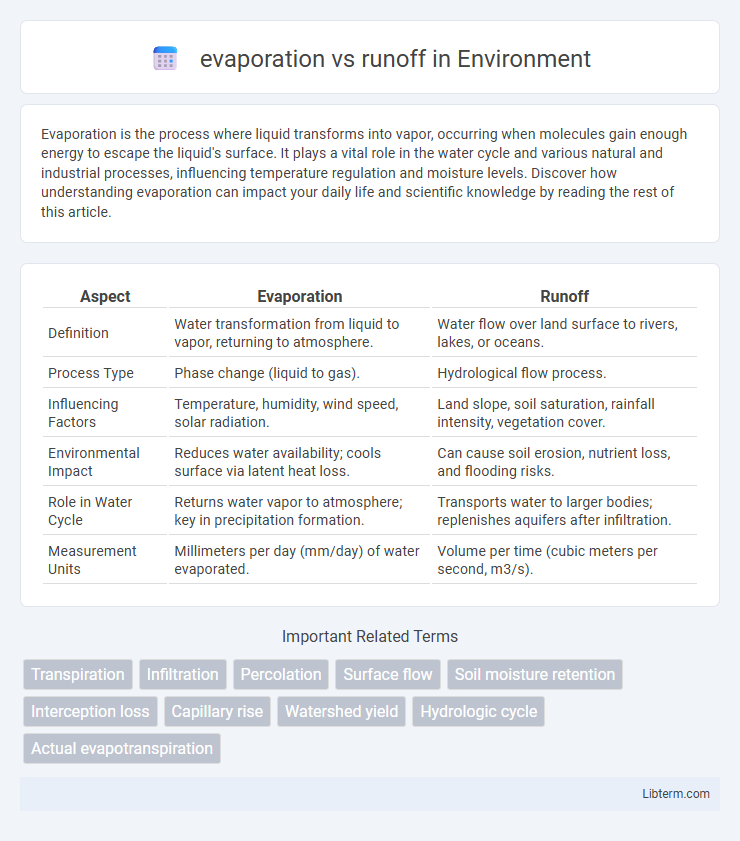Evaporation is the process where liquid transforms into vapor, occurring when molecules gain enough energy to escape the liquid's surface. It plays a vital role in the water cycle and various natural and industrial processes, influencing temperature regulation and moisture levels. Discover how understanding evaporation can impact your daily life and scientific knowledge by reading the rest of this article.
Table of Comparison
| Aspect | Evaporation | Runoff |
|---|---|---|
| Definition | Water transformation from liquid to vapor, returning to atmosphere. | Water flow over land surface to rivers, lakes, or oceans. |
| Process Type | Phase change (liquid to gas). | Hydrological flow process. |
| Influencing Factors | Temperature, humidity, wind speed, solar radiation. | Land slope, soil saturation, rainfall intensity, vegetation cover. |
| Environmental Impact | Reduces water availability; cools surface via latent heat loss. | Can cause soil erosion, nutrient loss, and flooding risks. |
| Role in Water Cycle | Returns water vapor to atmosphere; key in precipitation formation. | Transports water to larger bodies; replenishes aquifers after infiltration. |
| Measurement Units | Millimeters per day (mm/day) of water evaporated. | Volume per time (cubic meters per second, m3/s). |
Introduction to Evaporation and Runoff
Evaporation is the process where water transforms from liquid to vapor, primarily driven by solar energy, significantly influencing the water cycle and climate regulation. Runoff occurs when excess surface water from rain, melting snow, or irrigation flows over land, contributing to river discharge and affecting soil erosion and water quality. Understanding the balance between evaporation and runoff is essential for managing water resources and predicting hydrological responses in different ecosystems.
Definition of Evaporation
Evaporation is the process through which liquid water transforms into vapor and enters the atmosphere, driven primarily by solar energy and temperature. It plays a crucial role in the water cycle by removing moisture from surfaces such as soil, water bodies, and vegetation. In contrast, runoff refers to the flow of excess water across land surfaces, ultimately moving towards rivers, lakes, or oceans without evaporating.
Definition of Runoff
Runoff refers to the movement of excess surface water that flows over the land and into bodies of water such as rivers, lakes, or oceans after precipitation events like rain or snowmelt. Evaporation, in contrast, is the process by which water changes from liquid to vapor, returning moisture to the atmosphere. Understanding runoff is crucial for managing water resources, controlling soil erosion, and predicting flood risks in various ecosystems.
Key Differences Between Evaporation and Runoff
Evaporation is the process where water transforms from liquid to vapor, primarily occurring on surfaces like oceans, lakes, and soil, driven by solar energy and temperature. Runoff refers to water, often from precipitation or melting snow, that flows over land into rivers, lakes, and oceans without infiltrating the soil. The key difference lies in evaporation being a phase change removing water from the surface into the atmosphere, while runoff is water movement across the surface contributing to watershed hydrology and potential flooding.
The Science Behind Evaporation
Evaporation is a key process in the hydrological cycle where water changes from liquid to vapor due to solar energy, influenced by temperature, humidity, wind speed, and surface area. This phase transition removes water from soil and surface bodies, reducing runoff by limiting the amount of water available to flow over land. Understanding the molecular dynamics of evaporation helps predict water distribution and manage resources effectively in various ecosystems.
Factors Affecting Runoff
Runoff is primarily influenced by rainfall intensity, soil type, vegetation cover, and land slope, each affecting water absorption and surface flow rates. Impermeable surfaces and compacted soils reduce infiltration, increasing runoff volume and speed. Vegetation acts as a natural barrier, promoting water retention and reducing runoff by intercepting rainfall and enhancing soil permeability.
Environmental Impacts of Evaporation
Evaporation reduces available surface water, contributing to decreased soil moisture and impacting local ecosystems by altering plant water availability. High evaporation rates can lead to increased salinity in soils and water bodies, disrupting aquatic habitats and reducing biodiversity. Environmental stress from evaporation-driven water loss intensifies challenges in arid and semi-arid regions, exacerbating drought conditions and affecting agricultural productivity.
Environmental Impacts of Runoff
Runoff significantly contributes to environmental degradation by transporting pollutants such as pesticides, fertilizers, and heavy metals into water bodies, leading to eutrophication and loss of aquatic biodiversity. Unlike evaporation, which naturally recycles water into the atmosphere, runoff increases surface water pollution and sedimentation, disrupting ecosystems and degrading water quality. Managing runoff through green infrastructure and permeable surfaces mitigates these impacts, promoting sustainable watershed health.
Role in the Water Cycle
Evaporation plays a crucial role in the water cycle by transforming liquid water from surfaces such as oceans, lakes, and soil into water vapor, which then rises into the atmosphere to form clouds. Runoff, on the other hand, involves the movement of excess surface water from precipitation or melting snow, flowing over the land and eventually returning to rivers, lakes, and oceans. Together, evaporation and runoff regulate the distribution and movement of water within the hydrological cycle, influencing weather patterns, groundwater recharge, and ecosystem health.
Applications and Real-World Examples
Evaporation plays a crucial role in irrigation management by reducing water availability and affecting crop yields, particularly in arid regions where water conservation is essential. Runoff management is vital in urban planning to control flooding and prevent water pollution through sustainable drainage systems and permeable surfaces. Both processes are integral to watershed management, influencing decisions in agriculture, stormwater control, and environmental conservation.
evaporation Infographic

 libterm.com
libterm.com